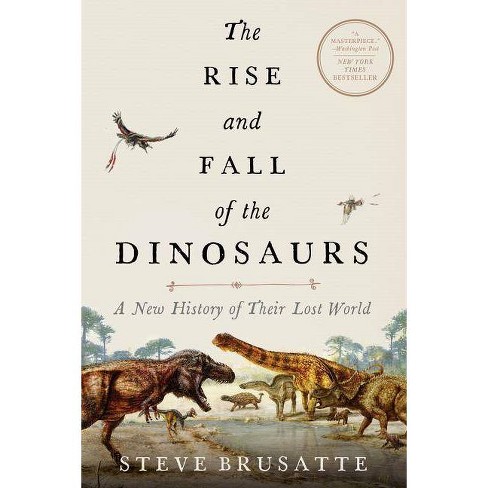 I covered Steve Brusatte’s Rise and Reign of the Mammals four months back. I took out his preceding volume The Rise and Fall of the Dinosaurs from the library last week. This book was first published in 2018, 349 pages of text, another 55 pages of acknowledgments, notes, and index.
I covered Steve Brusatte’s Rise and Reign of the Mammals four months back. I took out his preceding volume The Rise and Fall of the Dinosaurs from the library last week. This book was first published in 2018, 349 pages of text, another 55 pages of acknowledgments, notes, and index.
I think the last overview on the dinosaurs I read was Robert Bakker’s The Dinosaur Heresies twenty five years ago and that was originally published in the 80s. There have been some changes. Brusatte’s interest is especially in the Triassic Period and the rise of the dinosaurs. The dinosaur age is generally the Mesozoic divided into the Triassic, Jurassic, and Cretaceous periods. It was always presented in the past that the dinosaurs dominated the whole of the Mesozoic. Not so. Bakker had mentioned the dinosaurs coming from the Erythrosuci (Crimson Crocodiles) in the Triassic. That has changed.
Brusatte mentions a new dinosaur is discovered a week resulting around 50 or more new dinosaurs a year. He covers the end of the Permian Period and the mass extinction from massive volcanism that killed 90% of all life. That ended the domination of the gorgonopsids and other creatures as dicynodonts and pareiasaurs.
The archosaurs emerged from that geological holocaust. The group included Protodactylus, an early bipedal dinosauromorph. The archosaurs divided into the pseudosuchians who gave rise to the crocodiles and the avemetarsalians who included pterosaurs, dinosaurs, and birds.
The pseudosuchians dominated the Triassic. Various proto-crocodiles took on an array of forms. Dinosaurs had problems dealing with deserts. The unicontinent Pangea broke up 201 million years ago with a round of volanic activity causing another mass extinction. This episode taking out 30% of all species. The pseudosuchians were removed from supremacy and the dinosaurs took over.
Brusatte likes Tyrannosaurs as he devotes two chapters on them. I had known that the Tyrannosaurs were small at first in the Cretaceous. Allosaurs ruled the Jurassic. Charcarodontasaurs were top predators the first half of the Cretaceous. Tyrranosaurs got big in the mid-Cretaceous. I did not know that Tyrannosaurus rex was an invasive species from eastern Asia to North America. Brusatte calls its spread a blizkrieg destroying the competition. He does give a global perspective on distribution of different sorts of dinosaurs.
He has a chapter on the late Cretaceous and covers the ceratopsians such as Triceratops and the hadrosaurs. The end of the dinosaurs is covered in a chapter with the asteroid impact 66 millions years ago and some space on the rise of the mammals out of the asteroid dust.
This is a book for the lay public. Brusatte has a lot of personal anecdotes about fossil hunting in China, Montana, and Scotland and about some foreign paleontologists. He also stops to mention the greenhouse effect and dangers of carbon dioxide. He also takes space on early paleontologist Henry Fairfield Osborne as a wrong thinker. That appears to be a feature of newer pop paleontology books to mention how the founders were wrong thinkers. Still, this is a good book to get you up to date on dinosaurs. I knocked it off in a few nights.
Please give us your valuable comment